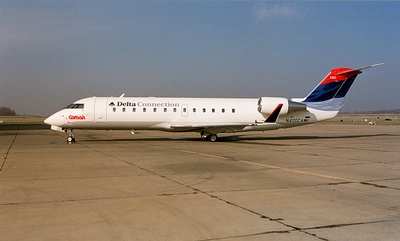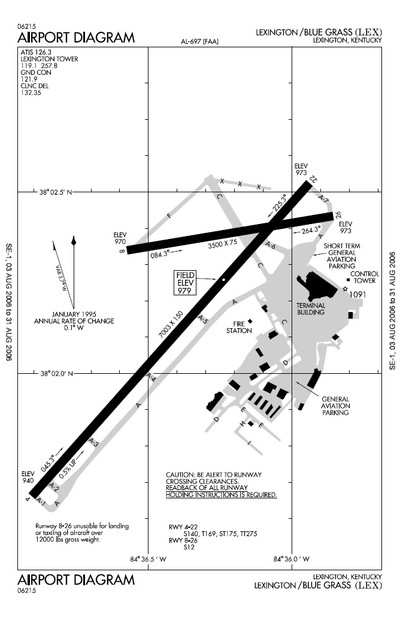 Editor's Note
-- On Monday, the National Transportation Safety Board released an
updated summary of information regarding the August 27, 2006 crash
of a Bombardier CRJ-100 upon takeoff from Blue Grass Airport in
Lexington, KY. As Aero-News
reported, of the 47 passengers and 3
crewmembers onboard, 49 were fatally injured and one (the first
officer) survived in critical condition.
Editor's Note
-- On Monday, the National Transportation Safety Board released an
updated summary of information regarding the August 27, 2006 crash
of a Bombardier CRJ-100 upon takeoff from Blue Grass Airport in
Lexington, KY. As Aero-News
reported, of the 47 passengers and 3
crewmembers onboard, 49 were fatally injured and one (the first
officer) survived in critical condition.
The following is an unedited update of factual information
developed during the Safety Board's investigation.
The Safety Board has completed the on-scene portion of the
investigation. All of the investigative groups will be
completing factual reports, which will be released to the public
when the public docket is opened in the next several months.
Accident Sequence
Flight 5191, from Lexington, Kentucky to Atlanta, Georgia, was
the third of three airplanes scheduled to take off in the early
morning. The previous two departures took off without
incident from runway 22. Flight 5191 was also cleared to taxi to
runway 22 and subsequently cleared for takeoff; however, the
airplane attempted to take off from runway 26. According to
recorded information, the aircraft began its takeoff roll,
accelerated to a maximum of about 137 knots, ran off the end of the
runway through the airport perimeter fence, and impacted trees on
an adjacent horse farm. The entire sequence took about 36 seconds.
The airplane was destroyed by impact forces and a post-crash
fire.

Aircraft Wreckage
Witness marks on scene indicate that all three landing gear were
on the ground as the airplane exited the runway. The main wreckage
was located approximately 1,800 feet from the end of the runway.
Both engines were examined at the accident site and no evidence of
pre-impact failure was noted and the thrust reversers were stowed.
The flaps were found in the takeoff position and no problems were
noted with any other airplane system or structure. The
wreckage from flight 5191 has been moved to a storage facility in
Georgia.
Recorders
The flight data recorder (FDR) and the cockpit voice recorder
(CVR) were recovered immediately and have provided valuable
information. Investigators are continuing to extract data from the
flight recorders, the air traffic control tape recordings and
airport video surveillance cameras. FDR data indicate that the
airplane stopped near the end of runway 26 for about 45 seconds
before the flight was cleared for takeoff. The airplane was cleared
for takeoff and 6 seconds later started to taxi onto runway 26.

It took about 36 seconds for the airplane to taxi onto runway 26
and complete the turn before power was increased to initiate the
takeoff. FDR vertical accelerometer data indicate that the airplane
departed the end of the runway about 32 seconds after the takeoff
was initiated. The FDR recording ended about 4 seconds later. Time
correlation of those data continues.
Operations/Human Performance
Operations/Human Performance group has completed initial
follow-up interviews at Comair headquarters in Covington, KY. The
group conducted airport observations under day and night
conditions; a simulator observation of Comair taxi and takeoff
procedures; and interviews with multiple persons including: ramp
personnel, flight instructors, check airmen, and several pilots who
had flown with the accident flight crew. These interviews provided
investigators with information about procedures and techniques used
by pilots for taxi and takeoff runway identification and
information about the accident flightcrew. Additionally, the
Director of Corporate Safety for Comair and FAA personnel
responsible for oversight of the Comair certificate were
interviewed.
The group gathered relevant documents pertaining to the accident
flight, flight crew training and evaluation, operations of the
CRJ100, and oversight of the airline.
Investigators are now reviewing interview summaries and
documentation to identify areas for further investigation and
evaluation. The group continues to evaluate the pilot actions
that led to the attempted takeoff on runway 26.
Airport Information/Survival Factors
 Runway 22 is 7003 feet
long, 150 feet wide, and is lighted for nighttime use. Runway 26 is
3500 feet long, 150 feet wide but marked to 75 feet wide, and is
not lighted and is restricted to daytime use only. In order to take
off from runway 22 it is necessary to taxi across the end of runway
26. An airport construction project, begun in 2004, was still
underway at LEX at the time of the accident. The project was
intended to mill and repave runway 4-22 and upgrade the safety
areas at both ends of runway 4-22, the main runway. This project
necessitated changes to some of the taxiways and signage. The group
continues to evaluate the airport taxiway and runway markings,
lighting and signage as well as additional information that was
available to pilots. The Airport/Survival Factors Group will also
be documenting the factors that may have contributed to the loss of
lives in this accident.
Runway 22 is 7003 feet
long, 150 feet wide, and is lighted for nighttime use. Runway 26 is
3500 feet long, 150 feet wide but marked to 75 feet wide, and is
not lighted and is restricted to daytime use only. In order to take
off from runway 22 it is necessary to taxi across the end of runway
26. An airport construction project, begun in 2004, was still
underway at LEX at the time of the accident. The project was
intended to mill and repave runway 4-22 and upgrade the safety
areas at both ends of runway 4-22, the main runway. This project
necessitated changes to some of the taxiways and signage. The group
continues to evaluate the airport taxiway and runway markings,
lighting and signage as well as additional information that was
available to pilots. The Airport/Survival Factors Group will also
be documenting the factors that may have contributed to the loss of
lives in this accident.
Air Traffic Control
At the time of the accident, there was one air traffic
controller in the tower. After handling several aircraft at the
beginning of his shift, there were several hours without aircraft
movements. In the 20 minutes leading up to the accident, there were
three departures, including Comair 5191, from LEX under his
control. The ATC group has interviewed several Lexington control
tower personnel and FAA air traffic personnel. The controller on
duty at the time of the accident relayed the following information
to investigators: he cleared the accident flight crew to take off
(from runway 22) and to fly runway heading (220 degrees); after
providing takeoff clearance for flight 5191, he turned away from
the window to perform an administrative task (traffic count); he
did not witness the accident, but heard the crash, turned around
and saw fire, and immediately activated the emergency response. As
in all investigations, the group will review the controller's
workload and duty schedule and the tower staffing level.
Toxicological Test
Toxicology testing performed on specimens from both pilots did
not detect any illicit substances or alcohol. An over the counter
decongestant, pseudoephedrine, was detected at a low level in the
first officer's blood.
Post Accident FAA Action
On September 1, 2006, the FAA issued a Safety Alert for
Operators (SAFO), titled, "Flight Crew Techniques and
Procedures that Enhance Pre-takeoff and Takeoff Safety." This alert
highlights existing FAA aircraft ground operation guidance and
reminds flightcrews that maximum attention should be placed upon
maintaining situational awareness during taxi operations.
 ANN's Daily Aero-Linx (04.16.24)
ANN's Daily Aero-Linx (04.16.24) Aero-News: Quote of the Day (04.16.24)
Aero-News: Quote of the Day (04.16.24) Airborne 04.10.24: SnF24!, A50 Heritage Reveal, HeliCycle!, Montaer MC-01
Airborne 04.10.24: SnF24!, A50 Heritage Reveal, HeliCycle!, Montaer MC-01 Airborne 04.12.24: SnF24!, G100UL Is Here, Holy Micro, Plane Tags
Airborne 04.12.24: SnF24!, G100UL Is Here, Holy Micro, Plane Tags Airborne-Flight Training 04.17.24: Feds Need Controllers, Spirit Delay, Redbird
Airborne-Flight Training 04.17.24: Feds Need Controllers, Spirit Delay, Redbird






